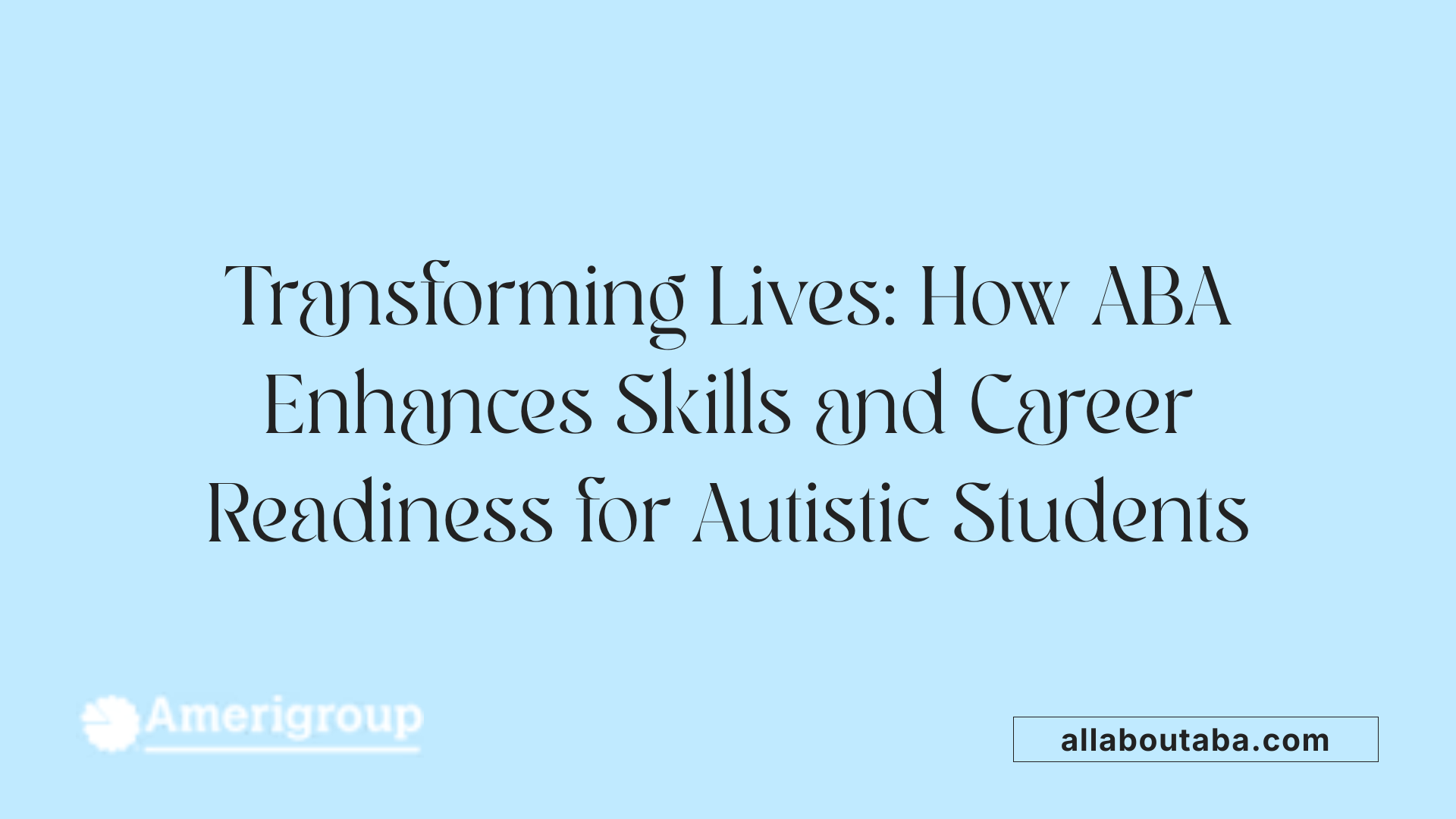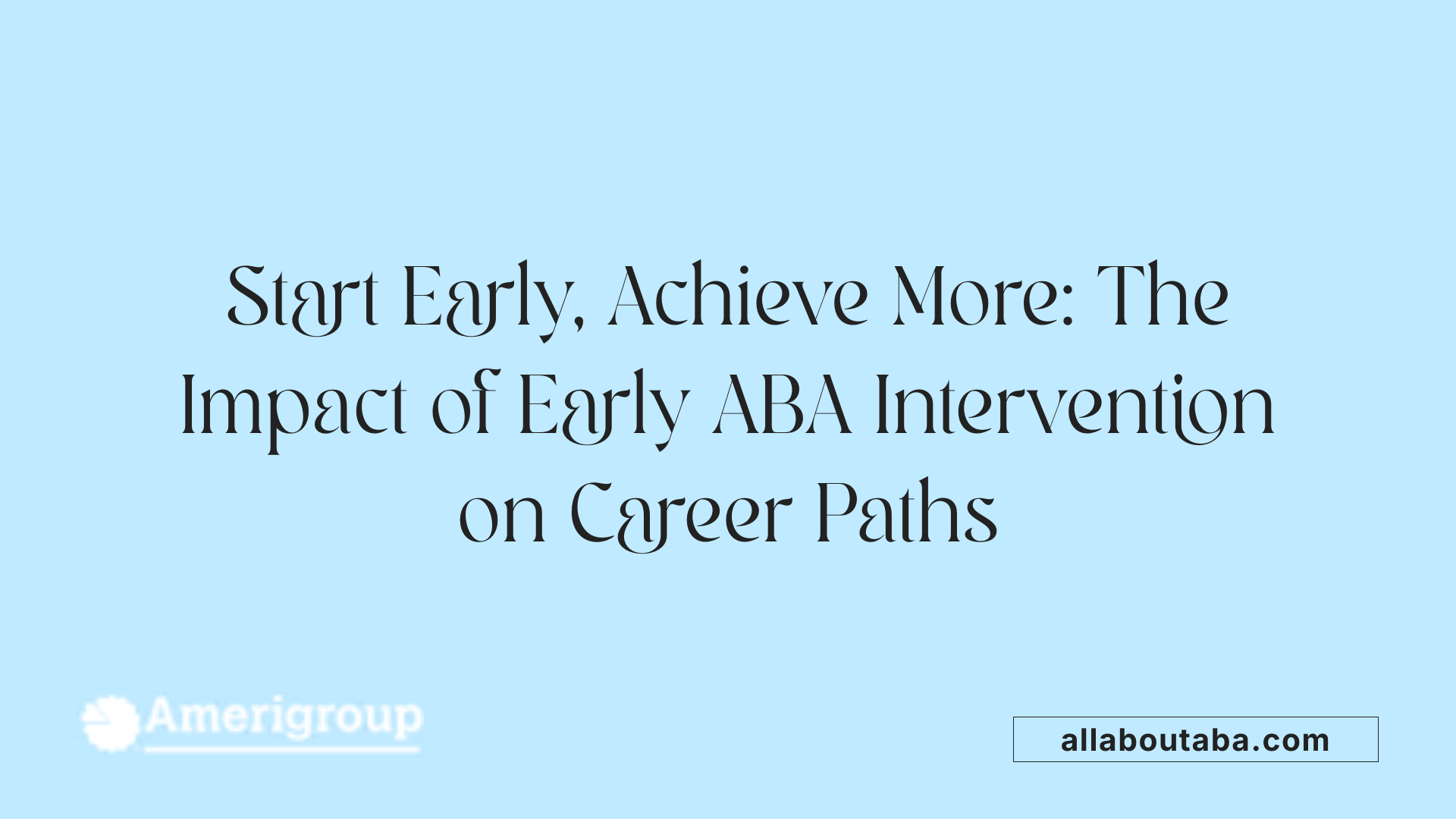How Schools Can Support Autistic Students In Career Prep
Laying the Foundation for Career Success
Supporting autistic students in career preparation is a multifaceted challenge that requires a comprehensive, individualized approach. Schools play a pivotal role in helping these students understand their strengths, develop essential soft skills, and explore diverse career pathways early on. This article explores effective strategies, programs, and therapies—such as Applied Behavior Analysis (ABA)—that schools can integrate to better prepare autistic students for successful transitions into the workforce and higher education.
Understanding Applied Behavior Analysis (ABA) Therapy and Its Role in Career Preparation

What is Applied Behavior Analysis (ABA) therapy?
Applied Behavior Analysis (ABA) therapy is a science-based approach designed to help individuals with autism spectrum disorder (ASD) develop essential skills and reduce unwanted behaviors. It works through analyzing the relationships between antecedents, behaviors, and consequences (often called the A-B-Cs of behavior), using positive reinforcement to encourage beneficial actions such as communication, social interaction, and daily living skills.
How does ABA help with skill development relevant to careers?
ABA plays a crucial role in preparing students with autism for careers by targeting behaviors and skills critical for workplace success. These include improving communication abilities, fostering social skills like teamwork and adaptability, and supporting problem-solving. By reducing anxiety and negative behaviors, ABA enables individuals to engage more confidently in learning environments and job settings. Structured ABA methods, including discrete trial training and pivotal response treatment, also help shape specific competencies that translate directly to career readiness.
How are ABA programs customized for individual needs?
Each ABA program is carefully tailored to the unique abilities and challenges of the individual, ensuring personalized goals and strategies. Licensed professionals such as Board Certified Behavior Analysts (BCBAs) design these customized plans, involving activities that range from play-based learning to focused skill-building exercises. This personalized approach ensures that therapy aligns with the individual's strengths and career interests, promoting independence and enhancing their readiness for both college and the workforce.
By supporting communication, social engagement, and adaptive behaviors, ABA therapy not only enhances day-to-day functioning but also lays a foundation for successful career pathways for students with autism.
Benefits of ABA Therapy for Autistic Students in School Settings

How does ABA therapy benefit individuals with autism?
ABA therapy provides comprehensive benefits for students with autism by promoting positive behavior changes and skill acquisition critical to education and career success.
Behavior improvement
ABA therapy uses evidence-based techniques such as positive reinforcement to reduce disruptive or harmful behaviors. By analyzing environmental factors influencing behavior, therapists create personalized plans that help students develop appropriate responses and coping mechanisms. This improvement in behavior facilitates a better learning environment and social integration.
Skill acquisition relevant to education and careers
The therapy supports the development of essential academic and life skills through structured activities designed to enhance learning capacity. Students acquire practical abilities such as attention control, problem-solving, and task completion, which are vital for academic achievement and future employment.
Enhancement of communication and social skills
ABA aids in strengthening both verbal and nonverbal communication by addressing deficits in these areas. It encourages social skill development, enabling students to engage more effectively with peers and educators. This boosts confidence and prepares them for successful participation in school and workplace settings.
In summary, ABA therapy offers tailored interventions that lead to improved behavior, enhanced communication, and essential skill building, enabling autistic students to thrive academically and prepare for career pathways.
Delivery and Techniques of ABA Therapy in Educational Environments

Who provides ABA therapy and how is it typically delivered?
ABA therapy is delivered by trained and credentialed professionals such as Board Certified Behavior Analysts (BCBAs) and certified therapists who may undergo background checks to ensure child safety. This therapy occurs across various environments including clinics, homes, schools, community settings, and residential facilities, tailored to each child's unique needs and goals.
In educational settings, ABA programs focus on teaching essential skills like communication, social interaction, daily living, and reducing challenging behaviors. These programs are highly individualized, utilizing systematic data collection to track progress and adjust interventions accordingly. Collaboration with families and educators is vital to ensure skills learned in therapy generalize to real-world settings. Providers prioritize clear communication about procedures and expectations, and plan for transition phases that help children apply their skills beyond therapy.
What are the common techniques used in ABA therapy?
Several core techniques form the foundation of ABA therapy, including:
- Positive Reinforcement: Rewarding desirable behaviors to encourage their repetition.
- Discrete Trial Training (DTT): Breaking down skills into small, structured steps using repetition and prompting.
- Visual Modeling: Using pictures or videos to demonstrate desired behaviors or skills.
- Prompting and Fading: Providing assistance initially and gradually removing prompts to increase independence.
- Behavior Chaining: Teaching complex tasks by linking simple, sequential steps into a complete behavior.
- Behavior Contracts: Setting clear expectations and consequences to encourage positive behavior.
Additional strategies include redirecting negative behaviors toward positive alternatives, script fading to support social skills practice, and extinction methods aimed at reducing harmful behaviors. These techniques are adapted and combined as needed to best support each student’s development within their educational environment.
Early Intervention and Timing for ABA Therapy in Career Development

At what age can ABA therapy begin for individuals with autism?
ABA therapy can begin at any age; however, early intervention yields the most significant benefits. For infants and toddlers, particularly between 6 months to 2 years, ABA-based approaches such as the Early Start Denver Model are used to enhance social communication skills and potentially reduce the severity of autism symptoms. The generally recommended optimal window to start intensive ABA therapy is between 2 and 6 years old, when children show the highest developmental gains.
Benefits of early support on career readiness
Starting ABA therapy early supports essential skills that form the foundation for future career success, such as communication, problem-solving, and adaptability. Early exposure to structured interventions helps students with autism build soft skills crucial for career readiness. These early interventions also prepare individuals to engage effectively with academic and social environments, which are vital for post-graduation outcomes.
Applicability across age groups
While early intervention is ideal, ABA therapy is adaptable and effective across all age groups. Older children, adolescents, and adults with autism can benefit from tailored ABA programs that focus on improving behaviors and skills relevant to career development, such as social interaction and task management. Continuous ABA support throughout development helps individuals navigate changing career goals and workplace demands.
In summary, although the optimal age for initiating ABA therapy is between 2 and 6 years old, starting as early as possible maximizes developmental advantages. Nevertheless, ABA therapy remains beneficial across the lifespan and plays a critical role in career preparation for individuals with autism.
Evidence Supporting ABA Therapy and Vocational Programs for Autism

What is the evidence supporting the effectiveness of ABA therapy?
Applied Behavior Analysis (ABA) therapy is widely recognized for its substantial benefits in improving developmental aspects in children with autism spectrum disorder (ASD). Comprehensive analyses of 29 studies reveal that ABA significantly enhances IQ scores, showing a large effect size of 0.740. It also improves communication skills, both expressive and receptive language, with effect sizes ranging from 0.600 to 0.750.
ABA's impact extends to adaptive behaviors, particularly socialization (effect size 0.444) and overall adaptive functioning (effect size 0.422), though its influence on daily living skills is more modest (effect size 0.138). These results establish ABA as a science-backed, customized approach fostering cognitive, communicative, and social development in children with ASD.
How do vocational programs impact employment outcomes for individuals with ASD?
Recent randomized controlled trials (RCTs) highlight vocational interventions as pivotal for improving employment rates among individuals with autism. One notable program, Project SEARCH, is a 9-month community-business internship model showing remarkable outcomes. In one study, 21 of 24 participants in the intervention group secured employment compared to only 1 in the control group, yielding an odds ratio of 4.654.
Another RCT indicated that 74% of participants receiving vocational support were employed post-graduation versus just 6% in control, with an odds ratio of 3.89. A third study reported a 53.3% employment acceptance rate after six months among the treatment group, compared to 25% for controls (odds ratio 3.43).
What role does virtual reality job interview training play in ASD vocational success?
Virtual reality job interview training (VR-JIT) has emerged as a promising tool to boost workplace readiness for people with ASD. The training simulates real-world interviews, enhancing confidence and communication skills. Its integration into vocational programs correlates with higher employment acquisition rates, underscoring the promising synergy between innovative technology and traditional vocational placements.
These findings collectively emphasize a growing, reliable evidence base supporting ABA therapy and structured vocational programs—including Project SEARCH and VR-JIT—as effective strategies to improve crucial outcomes in developmental and employment domains for individuals with autism.
| Intervention | Study Design | Employment Outcomes | Effect Size / Odds Ratio | Key Benefit Highlighted |
|---|---|---|---|---|
| ABA Therapy | Meta-analysis of 29 studies | Improved IQ, communication, socialization, adaptive behavior | Effect sizes up to 0.750 | Cognitive and social development |
| Project SEARCH | Randomized controlled trial | 21/24 employed in intervention vs 1 control | Odds ratio 4.654 | High post-internship employment |
| Vocational Training | Randomized controlled trial | 74% employment treatment vs 6% control | Odds ratio 3.89 | Employment after graduation |
| Virtual Reality Training (VR-JIT) | Randomized controlled trial | 53.3% employed treatment vs 25% control | Odds ratio 3.43 | Improved interview skills & confidence |
Career-Based Interventions: Exploring Strengths and Building Flexibility
Matching strengths and interests to career pathways
Career-based interventions for students with autism focus on helping them understand their unique strengths and interests. This process aligns these personal attributes with potential career options, enabling students to envision pathways that resonate with their abilities. Identifying this fit is crucial for fostering enthusiasm and long-term success.
Importance of exposure to varied careers
Gaining experience and knowledge about a wide range of career options is essential. Exposure reduces students' reliance on a single job idea and promotes flexibility. This broad perspective helps students adapt to new opportunities and challenges, preparing them for a dynamic job market.
Setting realistic goals and fostering adaptability
Setting achievable and practical goals supports the students' progress in career development. Flexibility and adaptability are cultivated through these goals, empowering students to adjust their career plans as needed. Encouraging this mindset helps them navigate future uncertainties confidently.
Building Essential Soft Skills for Career Success in Autism

What Soft Skills Are Important for Students with Autism?
Developing strong communication, teamwork, adaptability, and problem-solving skills is critical for students with autism preparing for their careers. These soft skills enable effective collaboration, help navigate changing circumstances, and foster creative thinking—all essential qualities valued by employers.
What Challenges Do Autistic Students Face in Developing These Skills?
Students with autism often encounter unique challenges when building soft skills. Difficulties with social communication, sensory sensitivities, and behavioral differences can make it harder to engage in teamwork or adapt to dynamic work environments. These obstacles require specialized support to ensure meaningful skill growth.
How Can Soft Skills Training Be Integrated Into Career Preparation?
Integrating soft skills development early into career-based interventions significantly enhances readiness for post-graduation opportunities. Programs often combine mentorship, targeted behavioral support, and real-world experiences to strengthen these abilities. For example, peer mentoring initiatives like the EASE program emphasize communication and social engagement to prepare students for college and workplace success.
Early and continuous focus on soft skills helps students with autism build confidence, independence, and adaptability needed to thrive in diverse career paths. Tailoring interventions to individual needs ensures that students not only understand technical job requirements but also master the interpersonal skills that drive sustained employment outcomes.
Innovative Peer Mentoring and Support Programs in Post-Secondary Transition
What is the EASE program and what are its objectives?
The EASE (Employment Assistance and Social Engagement) program, developed jointly by the Fulton Schools of Engineering and the College of Health Solutions at Arizona State University (ASU), is designed to support students with autism in their transition to college life. Its primary goal is to equip these students with essential social, communication, and behavioral skills required for success both academically and in their future careers.
How do mentors contribute and how does EASE collaborate with career services?
Mentors in the EASE program include both students and professionals experienced in working with individuals on the autism spectrum. Notable mentors like Sarah Conger focus on enhancing communication and behavioral skills, while others such as Gil Ruiz provide academic guidance. The program is expanding its collaboration with ASU Career and Professional Development Services to bolster skills related to resume building, workplace communication, and interview preparation.
What are the future plans for program expansion and returning to in-person activities?
Currently operating via Zoom due to the pandemic, EASE intends to resume in-person sessions to foster more direct engagement. Phase two of the program includes broadening its reach beyond engineering to encompass other STEM fields, reflecting a commitment to scale the model to meet the diverse needs of students with autism across disciplines.
University-Based Support Programs: Models and Services for Career Readiness
Examples of Specialized University Support Programs
Several universities offer dedicated support programs for students with autism spectrum disorder (ASD), each providing tailored services to help with academic and career success. Notable examples include:
- University of Alabama: Autism Spectrum Disorders College Transition and Support Program (UA-ACTS), offering academic and behavioral support at a cost of $3,000 per semester.
- Arkansas State University: EduCare program focuses on online students, emphasizing education, social competence, community living, and career readiness without additional fees.
- University of Arkansas: Autism Support Program assists students with high-functioning autism and related conditions to achieve college success.
- California State University, East Bay: College Link Program promotes independence by leveraging students' strengths to facilitate transition and success.
Range of Academic, Behavioral, Social, and Career Services
These programs often include a comprehensive suite of supports such as:
- Academic coaching to assist with coursework and learning strategies.
- Behavioral support addressing challenges associated with ASD.
- Social skills training and peer mentoring to enhance interpersonal communication.
- Career readiness services, including resume building, interview preparation, and workplace communication.
- Assistance with independent living skills to prepare students for life beyond college.
Common Features: Mentorship, Coaching, Social Skill Development
Mentorship is a cornerstone of many university programs, offering students guidance from trained peers or professionals experienced with autism. These mentors help develop communication, behavioral, and social skills crucial for college and workforce success. Academic coaching is widely available, supporting organizational skills and study habits, while social skills development activities and structured social events foster peer interaction.
Cost Considerations and Accessibility
Many university support programs are free or included in tuition and offer comprehensive services without extra fees. However, some programs like UA-ACTS require additional payment. Accessibility is often linked with registration through disability support services, as at Arizona State University and others. Students are encouraged to explore available options and consider financial and logistical factors when selecting programs.
| University | Program Name | Services Offered | Cost |
|---|---|---|---|
| University of Alabama | UA-ACTS | Academic & behavioral support | $3,000 per semester |
| Arkansas State University | EduCare | Education, social skills, community living, career prep | Free |
| University of Arkansas | Autism Support Program | Support for high-functioning ASD, Asperger's, PDD-NOS | Free or included in tuition |
| California State University, East Bay | College Link Program | Transition support, social skills, independence | Free or included in tuition |
Towards Inclusive and Effective Career Preparation
Schools equipped with evidence-based therapies like ABA, integrated career interventions, and robust support programs can profoundly impact the career trajectories of students with autism. Early and individualized planning that emphasizes both hard and soft skills, combined with peer and professional mentoring, fosters not only employability but also lifelong independence and fulfillment. As research and models continue to evolve, educational institutions are uniquely positioned to champion inclusive practices that open diverse career opportunities for autistic students, enabling them to thrive in the workforce and society.
References
- Career-Based Interventions for Students with Autism ...
- 'Easing' students with autism into college, career-readiness
- College Programs
- Interventions for improving employment outcomes ...
- 5 Careers Working with Autistic Children That Will Move You
- The effectiveness of applied behavior analytic interventions ...
- Applied Behavior Analysis (ABA)
- Applied Behavior Analysis (ABA)
- The Top 10 Reasons Children With Autism Deserve ABA
Other articles
Recent articles

Best Practices For Telehealth Autism Therapy

How To Help Autistic Children Develop Friendship Skills

How Schools Can Support Autistic Students In Career Prep

Best Strategies For Autism-Friendly Event Planning

Understanding Noncontingent Reinforcement In Autism Behavior Plans

How Drama Therapy Benefits Autistic Individuals

Best Practices For Autism-Friendly Fitness And Recreation Centers

Best Ways To Promote Healthy Social Media Use For Autistic Teens

How To Help Autistic Children Cope With Public Speaking

Autism And Strategies For Managing Unexpected Changes

Best Podcasts About Autism For Parents And Educators

Autism And The Impact Of Seasonal Changes On Behavior

The Role Of Diet In Managing Co-Occurring Conditions With Autism

Sleep Challenges In Autism And Practical Solutions

Best Ways To Build Daily Routines For Autistic Children

Best Practices For Supporting Autistic Entrepreneurs

Autism And Strategies For Navigating Large Social Gatherings

Adaptive Sports And Recreational Activities For People With Autism

Autism And The Benefits Of Story-Based Learning Activities

Understanding The Role Of Play In Autism Development

Autism And The Impact Of Environmental Noise On Learning

How To Create Autism-Friendly Community Spaces

Autism And Chronic Health Conditions: What To Know

The Role Of Care Managers In Autism Life Planning

How To Teach Social Boundaries To Autistic Children

How Autistic Individuals Experience Empathy Differently

How To Support Autistic Employees In Remote Work Settings

Autism And The Relationship Between Motor Skills And Learning

How To Create Community Resource Guides For Autism Families

How To Teach Daily Living Skills To Autistic Teens

Autism And The Impact Of Mind-Body Practices On Stress Reduction

Autism And The Benefits Of Outdoor Group Activities

How To Create Autism-Friendly Sensory Paths In Schools

Best Practices For Autism-Friendly Park And Recreation Areas

Autism And Strategies For Reducing School Refusal

Supporting Autistic Individuals In Public Speaking

The Role Of Diet In Managing Autism Symptoms

The Benefits Of Gardening Clubs For Autism Social Development

How To Prepare Autistic Children For Dental Visits

Autism And Employment: Career Paths That Work

Best Practices For Autism-Friendly Hotels And Lodging

The Impact Of Screen Time On Autism Development

Autism Screening Tools For Early Childhood

The Role Of Physical Exercise In Autism Therapy

Best Strategies For Supporting Autistic College Students

The Role Of Technology In Autism Early Detection

Sensory-Friendly Classroom Design Ideas For Autistic Students

The Role Of Speech Therapy In Building Social Communication Skills

Best Strategies For Handling Autistic Burnout In Adults

Autism And The Importance Of Predictability In Routine

Autism And Peer Education: Teaching Acceptance In Schools

Best Practices For Sensory-Friendly Libraries And Reading Rooms

Self-Advocacy Skills For Autistic Adults

The Role Of Technology In Autism Peer Communication

Promoting Physical Activity In Children With Autism

How To Prepare Autistic Children For Medical Procedures

The Role Of Social Media In Autism Advocacy And Awareness

The Impact Of Sensory Rooms In Public Facilities For Autism

How To Create An Autism-Friendly Holiday Celebration

Best Practices For Inclusive Education For Autistic Students

Autism And Mental Health: Recognizing Signs Of Distress

Best Practices For Sensory-Friendly Waiting Rooms

The Role Of Teachers In Early Autism Red Flag Identification

Autism-Friendly Housing Design Features

Autism-Friendly Housing Design Features

How Environmental Modifications Improve Autism Outcomes

Autism And Technology-Based Learning Tools

Supporting Autistic Children Through Changes In Routine

The Link Between Autism And Working Memory Challenges

Best Practices For Autism-Friendly Cooking Classes

Autism And The Benefits Of Structured Music Lessons

Best Books To Teach Kids About Autism Acceptance

Sensory Diets And Their Benefits For Autism Management

How To Prepare Autistic Teens For Driver’s Education

How To Teach Autistic Teens About Healthy Relationships

The Role Of Visual Prompts In Building Daily Habits For Autism

Addressing Sleep Regression In Children With Autism

Understanding Social Stories And How They Help Autistic Children

Navigating Insurance Coverage For Autism Therapy Services

How To Prepare Autistic Adults For Independent Travel

Supporting Autistic Individuals In Volunteer Work

How Mindfulness Practices Can Support Autism Well-Being

Understanding Hyperfocus And Special Interests In Autism

Understanding Stimming As A Self-Regulation Tool

Sensory-Based Interventions For Autism At Home

Best Ways To Introduce Self-Advocacy In Autistic Teens

Best Ways To Support Autistic Employees In Customer Service Roles

Best Practices For Autism-Friendly Volunteer Programs

Autism And The Benefits Of Sensory Play For Emotional Growth

Autism And Strategies For Building Peer Relationships

Understanding How Autism Affects Memory Processing

Autism And Strategies For Building Coping Skills In Teens

The Role Of Parent Training In Autism Intervention Programs

Autism-Friendly Workplace Accommodations

Using Visual Timers For Autism Time Management

What Is ABA Therapy?

Autism and Sleep

Do Plastic Toys Cause Autism?

Autism Facial Expressions

Autism and Motor Skills
We’re All About You, Your Family, and Your Child

